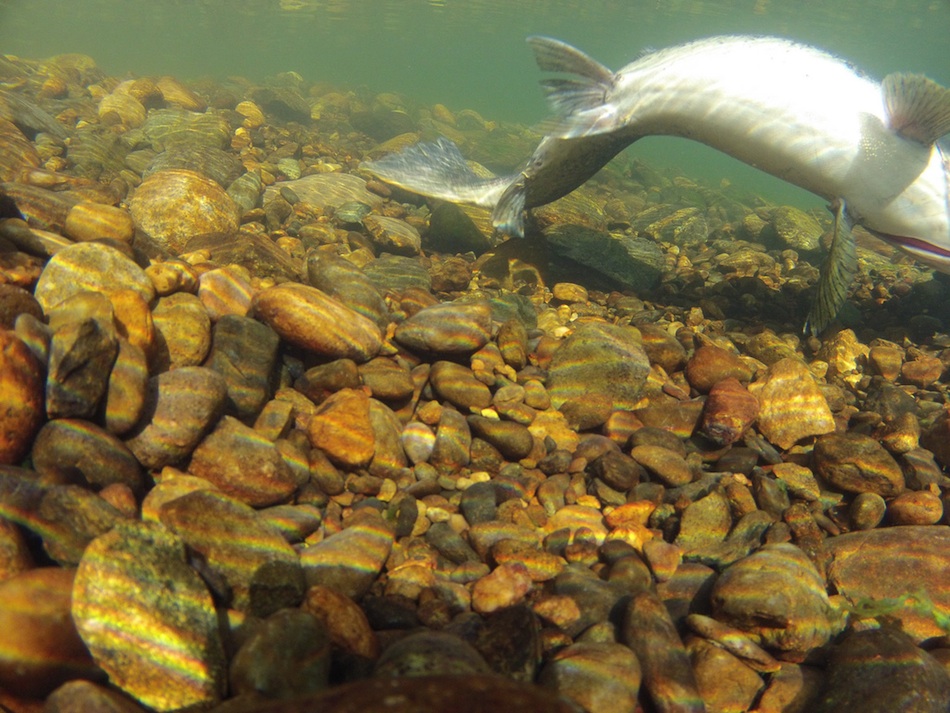Monday March 7, 2022

The relative proportion of males and females in a population can have a significant effect on its growth and stability. For humans, the typical ratio is about one to one, but for many species skewed sex ratios are the norm. For example, uneven sex ratios have been observed in multiple Pacific salmon species, but few studies have explored details of the sex-specific mortality driving these skewed ratios. In the Fraser River of British Columbia, where sockeye salmon support an important fishery, monitoring data have revealed a concerning trend: the proportion of females in many spawning populations in the watershed has been declining over the past 30 years. To try and ascertain why, a team of researchers reviewed past survival studies of sockeye in the system that considered sex as a factor. Their recent publication in the Canadian Journal of Fisheries and Aquatic Sciences (Hinch et al. 2021) suggests several possible factors, including that females may experience energy exhaustion, and demonstrates the potential of using sex-ratio monitoring to inform management and conservation actions.
The Fraser River produces more salmon than any other watershed in Canada, and of the five salmon species in the system, sockeye (Oncorhynchus nerka) are the most economically valuable. Due to their cultural and economic importance, sockeye have been studied in the system for nearly a century, and historic studies from the 1930s through the early 1990s noted a pattern of higher female abundance among returning adults. Numerous hypotheses were put forth to explain this skew, including higher aggression, larger body size, and more erratic swimming in male sockeye that may increase their risk of predation. For salmon, a lower number of males does not necessarily represent a significant problem, since any given male may spawn with multiple females to make up for the deficit. However, a lower number of females limits the number of eggs that can be spawned, thereby reducing the reproductive capacity of the population.
Data collected from the ‘90s onwards suggest the historic skew in the Fraser has flip-flopped, and males now outnumber females. The last three decades have also seen changes to climate conditions in the habitats that sockeye must navigate on their upstream migration, with temperatures increasing in both the ocean and river. These changes may cause a slew of challenges for salmon and could affect males and females in different ways. To search for evidence of such differential effects, the authors of this study reviewed data from past survival studies, with the goal of identifying trends in female mortality as well as possible explanations for these trends. The assessed studies included laboratory experiments in which sockeye were exposed to different stressors (such as varying temperatures, exhaustive exercise, and fishing gear entanglement) as well as field-based studies that monitored survival of PIT or acoustic tagged adults following exposure to different temperatures, turbulent fishways, and fishing gears.
In the 40 different comparisons across the 19 studies examined, male mortality was never greater than that of females, and on average female mortality was twice as high as males. In general, it appeared that the skewed increase in female mortality was greatest as the salmon neared the end of their spawning migration. The authors explored several hypotheses about what could cause this difference in mortality. One of the proposed reasons was energy exhaustion, as sockeye in the Fraser may use up to 91–96% of their fat reserves to get to their spawning grounds, and the additional energy that females put into egg production may make them more susceptible to depleting their fuel. The fact that the last 30 years have seen some of the highest flows recorded in the Fraser River may be causing increased female mortality during their upstream swim. Other hypothesized causes include greater baseline stress hormones in females, greater aerobic capacity in males, and greater susceptibility of females to pathogens.
The researchers note that it is unlikely any one of these factors is solely driving increased female mortality, but rather that several or all of them are acting together. As climate change continues to create new challenges for migratory fish like salmon, shifting ratios in the relative abundances of males and females may serve as a red flag to managers that a population is experiencing a new stressor. Today’s management of salmon harvest in the Fraser River is based on temperatures, discharge, and timing of river entry, but incorporating sex-specific management could provide a valuable additional tool to fisheries managers. Research into what drives sex-specific mortality in fish populations around the world can be used to develop approaches to mitigate these stressors, and help maintain reproductive potential.
This post featured in our weekly e-newsletter, the Fish Report. You can subscribe to the Fish Report here.
